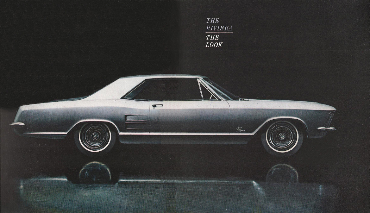Media | Articles
Top 10 cars of the ‘Mad Men’ era
The popularity of the AMC cable show “Mad Men,” set in the early 1960s, has focused attention on the products and styles of the Kennedy era. The early part of the decade, often dismissed as the last gasp of the 1950s rather than part of the “real” swinging 1960s, was in fact a high-water mark for American industrial design. Everything from typewriters to furniture reflected a new design sensibility – particularly cars. The flamboyant chrome and tail fins of the 1950s were replaced by understated cars that relied on sound design instead of gimmickry. It was an era when quality products and cutting-edge design still ruled in America.
Listed below are Hagerty’s picks for the top 10 cars of the “Mad Men” era. The leading collectible car price guide, “Hagerty’s Cars that Matter,” has determined approximately what each vehicle is valued at today.
1.1963 Buick Riviera ($28,000-$36,100): The ’63 Riv, introduced around the time of the Cuban Missile Crisis, was yet another reason to be thankful that the situation didn’t escalate into a nuclear conflict. After a trip to Europe, GM design head Bill Mitchell decided that he wanted an American personal luxury car that would combine the elegance of a Rolls Royce with the sportiness of a Ferrari. Originally planned as a revival of the LaSalle brand (a smaller Cadillac), Cadillac passed and the car was put up for grabs among the other GM divisions. Fittingly enough, Buick hired a slick Madison Avenue ad agency to make the case as to why they should get the Riviera. In the end, Buick won the right to sell what was arguably the most stylish American car built in the early 1960s.
2. 1963 Corvette Sting Ray ($61,000-$74,000): The Corvette almost didn’t make it out of the 1950s — the underpowered six-cylinder 1953-54 car was a commercial flop. GM’s A-list talent of Bill Mitchell, Larry Shinoda and Zora Arkus-Duntov were brought in to make the Corvette into a world-class sports car. The second-generation car was an unqualified success and the Corvette would never again be in serious danger of cancellation. The 1963 coupe was notable for a one-year-only feature that Mitchell himself demanded — a split rear window that looked great but compromised rear vision. Some would argue that what’s behind a Corvette isn’t important.
3. 1961-63 Ford Thunderbird ($35,000-$45,000): The original 1955-57 Ford Thunderbird was Ford’s answer to the Chevrolet Corvette. Unlike the 1953 Corvette, the softer and more feature-packed T-Bird was an immediate sales success. Sensing a broader market for a four-seater car, Ford redesigned the T-Bird in 1958. The new car, dubbed the “squarebird” by fans, was a busy and far less-attractive car than the original. The 1961 version, nicknamed the “bulletbird” for its streamlined style, was a far more successful design.
Marketplace
Buy and sell classics with confidence
4. 1961-63 Lincoln Continental ($18,000-$24,000): Few people remember that Lincoln was in serious danger of being shut down by Ford in the late 1950s. They needed a blockbuster new car to save the marque. They got it in the slab-sided, Elwood Engel-designed 1961 Continental. Originally planned as the new Thunderbird, the car was reworked as a much larger four-door design with center-post, outward-opening “suicide” doors. The ’61 Continental, now forever associated with the Kennedy assassination, remains one of the most significant American car designs of the 1960s.
5. 1961 Chrysler 300G ($59,000-$67,000): Most collectors consider the 1961 300G to be the last of Chrysler’s classic “letter cars.” It’s the only car on this list firmly rooted in the flamboyant 1950s rather than the early 1960s; it still sported huge tailfins even after that fad had passed. The 300G was a brute of a car with up to 400 horsepower available. The name and the swagger of the car live on in Chrysler’s modern 300 sedans.
6. 1963 Studebaker Avanti ($23,000-$31,000): Studebaker and American Motors Corporation were the last of America’s independent automakers. On the strength of its Jeep brand, AMC survived until the 1980s. Studebaker wasn’t so lucky. Styled by a team lead by famed industrial designer Raymond Loewy, the Avanti was Studebaker’s last gasp, a striking European-style GT with an optional supercharger. It was rushed to market with predictable results. Studebaker died in 1966, but amazingly, the Avanti lived on, manufactured independently for more than 20 years.
7. 1962-63 Cadillac Coupe De Ville ($14,000-$20,000): No list of early 1960s American cars is complete without a Cadillac. In an era when nobody could have imagined Japanese prestige cars like Lexus or Infiniti, Cadillac was still at the top of the food chain and the Coupe De Ville was a neon sign that an executive or businessman had arrived at a particular station in life. Most of the major convenience options we’re familiar with today were available on 1960s Caddies, including air conditioning, power seats, automatic dimming headlights and a remote control AM/FM radio.
8. 1962-64 Studebaker Gran Turismo Hawk ($27,000-$32,000): Although Studebaker went out of business in 1966, it wasn’t because their products lacked style. The GT Hawk was elegant and understated and quite European in execution – Studebaker was the U.S. distributor for Mercedes in the 1950s. The interiors had full instrumentation and enthusiast publications like Road & Track reported that Hawks handled much better than typical American cars of the era.
9. 1963 Buick Electra 225 ($13,000-$19,000): If you didn’t want to make a statement with a Coupe De Ville – or if you couldn’t – an Electra 225 was your car. Restyled for 1962, it still carried the four side “ventiports” that remain a part of Buick style. A big 401 cubic-inch V8 provided more than adequate power at the expense of single-digit gas mileage, but with gas prices around $0.31 a gallon in 1962, few people were worrying about it.
10. 1963 Ford Galaxie XL Convertible ($31,000-$36,000): If the solar system or interstellar space simply wasn’t big enough, there was the Galaxie. With a whopping 119” wheelbase (that’s about six inches longer than a new Explorer) the Galaxie convertible wasn’t a car you wanted to parallel park in Manhattan. Still, six people could fit inside and it was easy to put down the top and on a sunny day, forget about the Berlin Wall, the Bay of Pigs and the several thousand Soviet nuclear missiles pointed in our direction.











On your list, number 9, listed a 63 Buick Electra 225. Then, the little story told of a 62. I think maybe someone didn’t do any proofreading.